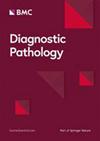22 例缪尔氏腺肉瘤的临床病理分析和 DICER1 基因突变测序
IF 2.3
3区 医学
Q2 PATHOLOGY
引用次数: 0
摘要
缪勒氏腺肉瘤是一种罕见的恶性肿瘤,给诊断和治疗带来了挑战。在本研究中,我们对22例腺肉瘤的临床病理特征进行了分析,尤其侧重于筛查DICER1热突变。研究对象包括2020年至2022年6月期间在华西第二医院登记的腺肉瘤患者。研究人员采用桑格测序技术筛查了22例腺肉瘤中DICER1的RNase IIIb结构域中的体细胞热点突变。只有一名患者出现了非DICER1热点突变的DICER1突变。在这 22 例患者中,所有患者都接受了全子宫切除术和双侧输卵管切除术,其中 14 例患者接受了辅助治疗。总之,我们对22例Müllerian腺肉瘤的研究侧重于临床病理特征和DICER1热点突变的存在。虽然我们的研究结果没有发现研究样本中存在任何 DICER1 突变,但这一阴性结果缩小了腺肉瘤的遗传范围,为该领域提供了有价值的信息,并强调了进一步研究驱动这种恶性肿瘤的其他分子途径的必要性。本文章由计算机程序翻译,如有差异,请以英文原文为准。
Clinicopathological analysis of 22 Müllerian adenosarcomas and the sequencing of DICER1 mutation
Müllerian adenosarcoma, a rare malignancy, presents diagnostic and therapeutic challenges. In this study, we conducted an analysis of the clinicopathological characteristics of 22 adenosarcomas, with a particular focus on screening for DICER1 hot mutations. The cohort consisted of patients with adenosarcoma who were registered at the West China Second Hospital between the years 2020 and June 2022. Sanger sequencing was employed to screen for somatic Hotspot mutations in the RNase IIIb domain of DICER1 in the 22 adenosarcomas. Only one patient exhibited a DICER1 mutation that was not a DICER1 Hotspot mutation. Among the 22 patients, all underwent total hysterectomy with bilateral salpingo-oophorectomy, and 14 out of these 22 patients received adjuvant treatment. In summary, our study of 22 Müllerian adenosarcomas focused on the clinicopathological features and the presence of DICER1 Hotspot mutations. Although our findings did not reveal any DICER1 mutations in the studied samples, this negative result provides valuable information for the field by narrowing down the genetic landscape of adenosarcomas and highlighting the need for further research into alternative molecular pathways driving this malignancy.
求助全文
通过发布文献求助,成功后即可免费获取论文全文。
去求助
来源期刊

Diagnostic Pathology
医学-病理学
CiteScore
4.60
自引率
0.00%
发文量
93
审稿时长
1 months
期刊介绍:
Diagnostic Pathology is an open access, peer-reviewed, online journal that considers research in surgical and clinical pathology, immunology, and biology, with a special focus on cutting-edge approaches in diagnostic pathology and tissue-based therapy. The journal covers all aspects of surgical pathology, including classic diagnostic pathology, prognosis-related diagnosis (tumor stages, prognosis markers, such as MIB-percentage, hormone receptors, etc.), and therapy-related findings. The journal also focuses on the technological aspects of pathology, including molecular biology techniques, morphometry aspects (stereology, DNA analysis, syntactic structure analysis), communication aspects (telecommunication, virtual microscopy, virtual pathology institutions, etc.), and electronic education and quality assurance (for example interactive publication, on-line references with automated updating, etc.).
 求助内容:
求助内容: 应助结果提醒方式:
应助结果提醒方式:


